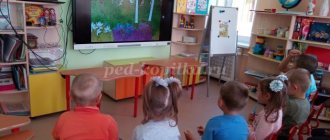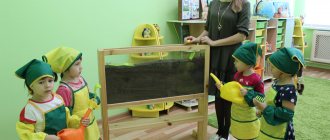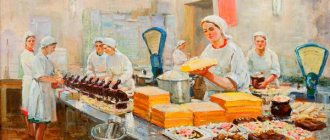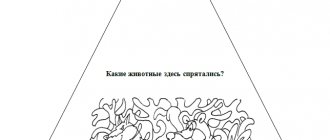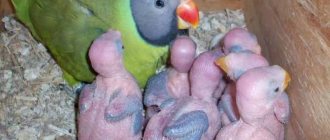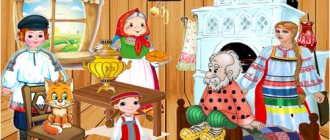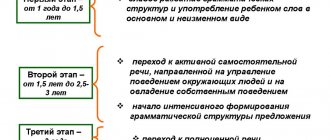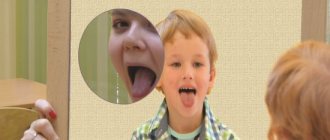Topic of the week: “Pets”
Children should know:
- names of domestic animals: cow, cat, dog, goat, horse, pig, sheep, ram, horse; - names of cubs and family: calf, kitten, puppy, foal, lamb, piglet, kid; — the concept of “pets”; - the external signs of each, what they eat, how they voice; - where they live, what benefits they bring;
Expanding children's vocabulary:
Nouns : animal, horse, horse, foal, foals, cow, bull, calf, calves, sheep, ram, lamb, lambs, goat, goat, kid, kids, pig, hog, piglet, piglets, dog, dog, puppy, puppies, cat, cat, kitten, kittens, head, muzzle, ears, body, four paws (legs), horns, wool, tail, house, man, benefit, wool, meat, milk, leather, herd, farm, stable, hay, swill, horns, mane, hooves, barnyard, cowshed, kennel, booth, stable, pigsty, pasture, sheepfold, milkmaid, machine milking operator, pig farm, groom, shepherd, shepherd.
Adjectives : necessary, useful, kind, herbivorous, domestic, fluffy, smooth, horned, fierce, affectionate, evil, stubborn;
Verbs : start, feed, look after, protect, love, neigh, moo, bleat, meow, grunt, bark, meow.
Finger gymnastics “Burenushka”.
Give me milk, Buryonushka, (children show the cow’s “horns”, bend their index finger and little finger) At least a drop on the bottom. Kittens are waiting for me, little kids. Give them a spoonful of cream (they bend one finger at a time, starting with the little fingers, on both hands) A little cottage cheese, on both hands. Butter, curdled milk, milk for porridge. Cow's milk gives everyone health! (The cow’s “horns” are shown again)
Grammatical structure of speech
— Didactic exercise “One-many” (formation of plural nouns):
cat - cats - many cats foal - foals - many foals dog - dogs - many dogs kitten - kittens - many kittens pig - pigs - many pigs horse - horses - many horses
— Didactic exercise “Call it affectionately” (formation of nouns with diminutive suffixes in singular and plural):
cow - cow horse - horse cat - kitty sheep - sheep dog - dog sheep - sheep ram - lamb
— Didactic exercise “Count to five” (coordination of nouns with numerals):
One cat, two cats, three cats, four cats, five cats One cat, ..., five cats One dog, ..., five dogs One horse, ..., five horses One sheep, ..., five sheep One cow, two cows, three cows , four cows, five cows
— Didactic exercise “Guess who it is?” :
Guards, chews, barks? – the dog grunts, digs? - The pig neighs, runs, jumps? – Does the horse meow, lap, scratch? – cat Moos, chews, walks? - cow
— Didactic exercise “Who has who?” (word formation exercise):
Goat - goat - kids Cow - bull - calves Pig - boar - piglets Horse - horse - foals Dog - dog - puppies Sheep - ram - lambs Cat - cat - kittens Goat - goat - kids
— Didactic exercise “Who gives what voice?”:
The horse neighs. The sheep bleats. The dog barks and growls. The cat purrs and meows. The pig grunts. The cow moos.
— Didactic exercise “Whose? Whose? Whose?" (formation of possessive adjectives):
Dog kennel. - Whose kennel? - dog. Milk from goats, cows. - Whose milk? - goat, cow. Horns of ram, cow, goat. - Whose horns? - lamb, cow, goat. Tail of a horse, cat, dog. -Whose tail? - horse, cat, dog. Hooves of a cow, horse. -Whose hooves? - cows, horses. Goat beard. - Whose beard? - goat. Cat paws. -Whose paws? – feline.
— Didactic exercise “Who lives where?” (use of the nominative case of nouns):
lives in a barn (who?) - a cow lives in a pigsty (who?) - a pig lives in a kennel (who?) - a dog lives in a barn (who?) - a sheep, a ram lives in a barn (who?) - a goat
— Didactic exercise “Continue the sentences”:
The dog barks, gnaws bones, guards... (house). The horse neighs, grazes... (in the meadow). The cat purrs, catches mice... (in the basement).
— Didactic exercise “Correct the sentence”:
The dog cackles at strangers. — The dog barks at strangers. The cow gives wool. - The cow gives milk. The cat pecks at the milk. - The cat laps the milk. The pig growls in the trough. - The pig is splashing in the trough. The cat grunts on the sofa. – The cat is purring on the sofa.
— Didactic exercise Compose a story about a pet according to plan.
This is a goat, a domestic animal. The body is covered with fluffy hair. The head is small, elongated, with protruding horns. Loves green grass. Produces tasty meat, milk, wool. A goat lives in a barn, a stable.
Advice from a speech therapist to parents
Show the child (if possible living) domestic animals - a cat, a dog, a cow, a goat, a horse, a pig, a sheep. Discuss the external signs of each, talk about what they eat.
Tell children how pets benefit people.
Read poems, stories about pets, look at illustrations.
Sample questions for children:
— Why are these animals called “domestic”? — What benefits does (horse, cow, sheep, etc.) bring to people? - Why does a horse have hooves on its legs? - Why can’t you hear the cat walking?
Summary of a subgroup speech therapy lesson on the topic “Pets”
Yanina Makarova
Summary of a subgroup speech therapy lesson on the topic “Pets”
Topic: " Pets "
1. Systematize children’s knowledge about domestic animals and their cubs .
2. Development of fine and articulatory motor skills; Breathing exercises.
3. Teach children to coordinate numerals with nouns.
4. Develop logical thinking based on lexical topics.
5. Develop attention and integrity of perception.
6. Continue teaching children to coordinate speech with movements.
7. Continue to develop grapho-motor skills.
8. Summary of the lesson .
Equipment: pictures of domestic animals and their cubs , cards with outline images of domestic animals for counting pets superimposed on each other , pictures of wild animals (hedgehog, wolf, colored pencils, magnetic board, magnets.
